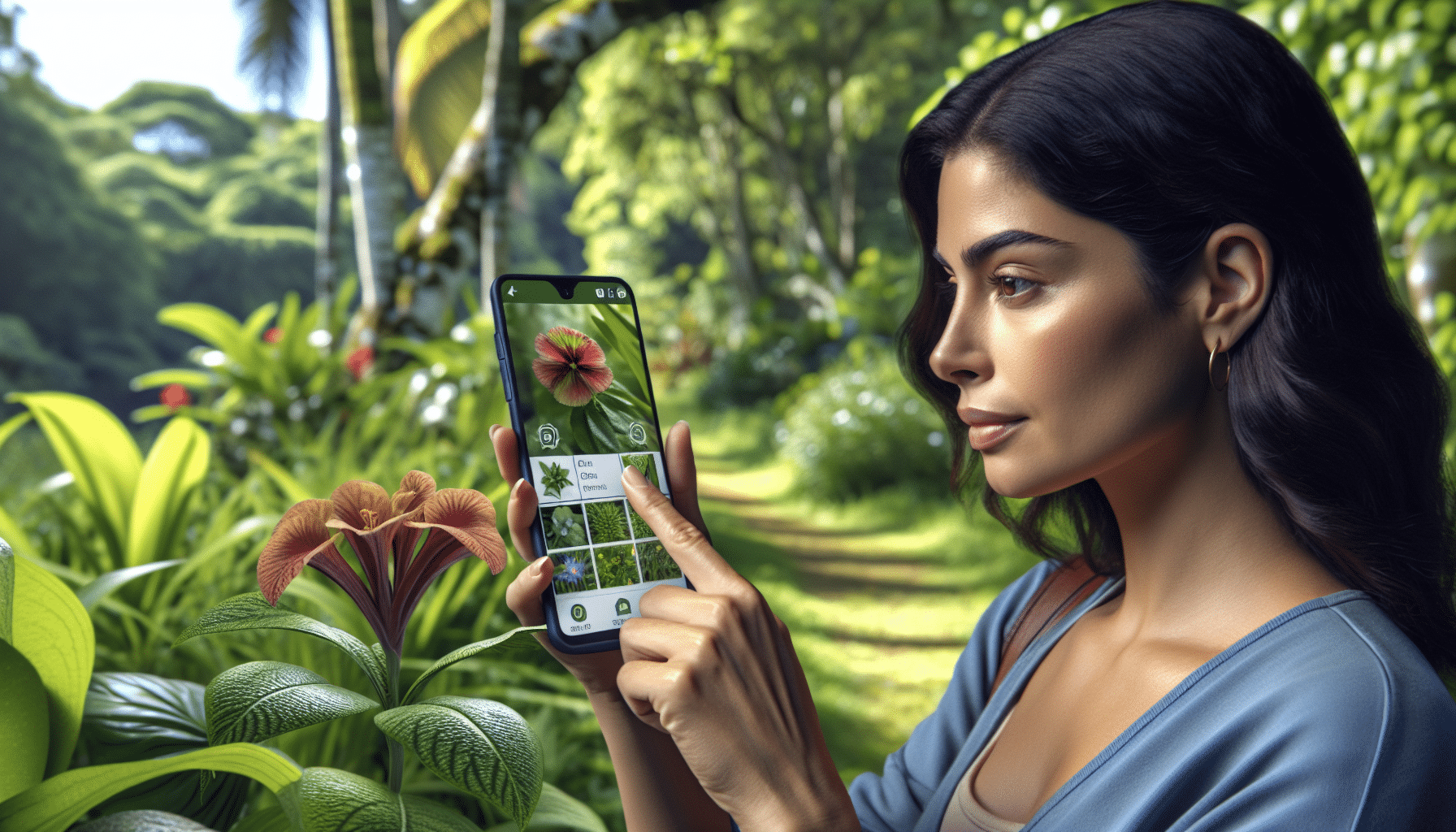Ads
Identify plants instantly with this app.
In a world where technology advances by leaps and bounds, we often forget the simplicity and beauty of the nature that surrounds us.
Ads
Plants, in their infinite shapes and colors, offer us not only oxygen, but also serenity, inspiration, and a reminder of the amazing diversity of our planet.
However, for many of us, the plant kingdom remains an enigma.
Ads
How many times have you walked past a plant and wondered what its name is or what properties it has?
In this digital age, where answers are just a click away, an innovative solution has arrived that promises to bridge the gap between humans and the fascinating world of botany: a revolutionary app capable of identifying plants in a matter of seconds.
Imagine yourself strolling through a botanical garden, an urban park, or even hiking in the woods.
You are surrounded by a multitude of plants, each with a unique story, life cycle, and role in the ecosystem.
With a simple gesture, such as taking a photo with your smartphone, you can access a comprehensive database that will reveal the name of the plant, its characteristics, and interesting facts you may not have known.
This technology not only fuels curiosity but also promotes a greater understanding and appreciation for biodiversity, encouraging users to connect more deeply and consciously with their natural surroundings.
In this article, we'll explore in detail how this app is transforming the way we interact with the green world.
From basic functionality to advanced features, you'll discover how artificial intelligence and machine learning combine to provide an educational and exciting experience.
In addition, we will address the importance of plant conservation, highlighting how accessible knowledge can motivate concrete actions to protect our flora.
We will also analyze how this tool can be an invaluable resource for both botany enthusiasts and experts, enriching research and educational activities.
It's not just an app for identifying plants, but a gateway to a world of ecological possibilities.
Through user stories and practical application examples, we'll show you how this technology can change our relationship with nature.
From beginner gardeners who want to learn more about their plants to curious adventurers who want to document every discovery, this app has the potential to turn every outdoor trip into an educational adventure.
Prepare to embark on a journey of knowledge that will connect you more intimately and sustainably with the planet we call home.
The digital revolution in botany: technology at the service of knowledge
Over the past decade, we have witnessed a digital revolution that has transformed the way we interact with the natural world.
SEE ALSO:
- Your photos now look like Ghibli-style cartoons
- Car diagnostic scanner app
- The best app to detect earthquakes
- The experience of following Formula 1
- TOP online tools for Minecraft
Technology has advanced by leaps and bounds, allowing us to access detailed information with just a few clicks on our mobile devices.
One of the areas where this advancement has had a significant impact is botany.
Mobile apps for identifying plants have become indispensable tools for nature enthusiasts, gardeners, and scientists alike.
These apps not only allow us to identify plant species in a matter of seconds, but also educate us about their characteristics, habitats, and care.
The impact of these digital tools is profound, opening new doors for learning and conserving our natural environment.
The ability to quickly and accurately identify plants is invaluable. Previously, this required in-depth botanical knowledge or access to specialized guides and books.
Today, thanks to artificial intelligence and machine learning, applications can analyze plant images and deliver almost instantaneous results.
These tools use extensive databases and sophisticated algorithms to recognize patterns and compare images, providing users with detailed information about a given plant.
Additionally, internet connectivity allows these applications to be constantly updated with new information, ensuring that users have access to the most recent data.
An example of an app that has captured the public's attention is PlantSnap.
This app not only identifies plants, but also offers information about their toxicity, medicinal uses, and interesting facts.
In addition, PlantSnap encourages the creation of a community of users who share discoveries and tips.
This social interaction adds extra value, as users can learn from each other and participate in conservation activities.
Technology is not only facilitating access to botanical knowledge, but also promoting collaboration and commitment to the environment.
Key features of a plant identification app
When choosing a plant identification app, it's essential to consider the features it offers.
These features not only determine the app's accuracy and efficiency, but also improve the user experience.
Below, we analyze some of the most important functionalities that an application of this type should have.
Intuitive and user-friendly interface
An intuitive interface is crucial to ensure users can easily navigate the application.
The best plant identification apps feature a clean, organized design, with clear icons and easily accessible options.
The simplicity of the design helps users, regardless of their experience level, use the app without any complications.
Plus, a good app offers clear instructions on how to take photos to get the best identification results.
Extensive and updated database
The accuracy of a plant identification app depends largely on its database.
An extensive and up-to-date database ensures that the app can recognize a wide variety of plant species, including less common ones.
The best apps collaborate with botanists and experts to include detailed information about each species, such as its geographic distribution, physical characteristics, and ecological data.
Additionally, regular database updates ensure that users always have access to the most accurate and up-to-date information.
Advanced reconnaissance capabilities
Advanced recognition capabilities are essential for an app to accurately identify plants.
This includes the ability to analyze fine details in images, such as leaf shape, flower pattern, and stem texture.
Artificial intelligence and machine learning are key technologies that enable applications to continuously learn and improve their recognition capabilities over time.
The combination of these technologies with advanced algorithms enables applications to deliver reliable results, even in difficult lighting conditions or with low-resolution images.
Comparison of popular applications for identifying plants
The market is full of apps that promise to help users easily identify plants. However, not all offer the same level of quality or functionality.
Below is a comparison table of some of the most popular apps currently available, highlighting their key features, advantages, and disadvantages.
App Key Features Pros Cons PlantSnap Plant recognition, user community, toxicity data Large database, constantly updated, active community Some features require a premium subscription PictureThis Plant identification, care tips, disease diagnosis User-friendly interface, useful for gardeners, includes practical tips Ads in the free version LeafSnap Leaf identification, botanical information, easy to use Clean design, educational focus, accessible for all levels Less extensive database than other apps
This comparison table illustrates how each app differs in terms of its features and approach.
PlantSnap is a great option for those looking for an active community and extensive database, while PictureThis stands out for its practical plant care tips.
On the other hand, LeafSnap is ideal for those who prefer a simple and educational user experience.
By exploring these options, users can choose the app that best suits their specific needs.

Conclusion
Concluding an article about an innovative app that allows us to identify plants in seconds not only represents a close to a technological exploration, but also an invitation to rethink our relationship with the natural environment.
Throughout the text, we discuss how this digital tool revolutionizes the way we interact with the flora around us, highlighting its ease of use, accessibility, and educational potential.
First, let's recap the key benefits this app offers its users.
The ability to identify plants in seconds opens up a wealth of opportunities for botanists, educators, students, and anyone with an interest in the natural world.
Its intuitive interface and use of artificial intelligence make botanical knowledge accessible to everyone, regardless of their level of experience.
This democratization of knowledge is essential in a world where digitalization and environmental education increasingly intersect.
In addition, we discussed how this app not only satisfies individual curiosity but also has broader implications for environmental conservation.
By providing information about plant species, their habitats, and their conservation status, users are better equipped to make informed decisions that affect the environment.
This knowledge can foster sustainable practices, encourage the protection of endangered species, and raise awareness of local biodiversity.
The app also acts as a formidable educational tool.
When integrated into curriculum, it can enrich the learning experience by connecting students directly with nature.
Through gamification and interactive challenges, students can experience the diversity of flora firsthand, which not only enhances their botanical understanding but also cultivates a lasting respect for the natural world.
In the current context of climate change and biodiversity loss, tools like this app are more important than ever.
They provide a bridge between scientific knowledge and the general public, encouraging people to actively participate in preserving their environment.
Through accurate plant identification and the dissemination of valuable information, this technology brings us one step closer to a greener, more sustainable future.
We invite our readers to download the app and explore the wonders of the plant kingdom for themselves.
In doing so, you will not only be satisfying your curiosity, but also contributing to a greater awareness and appreciation of our planet.
We encourage you to share your discoveries and experiences with friends and family.
Each plant identified is a step toward deeper knowledge and a stronger connection with nature.
Finally, we encourage everyone to leave comments about their experiences with the app. Your feedback is invaluable in improving and expanding the capabilities of this tool.
Share this article on your social media and with your close circles to help spread the word about the importance of environmental education and conservation.
By fostering an active and engaged community, we can all contribute to a more informed and aware world.
For those interested in further study, we recommend consulting recent studies on biodiversity and the use of technology in environmental education, available at Google Scholar and relevant academic databases. You can also visit WWF to learn more about how you can contribute to the conservation of endangered species.
In conclusion, the application we present is not just a technological tool; it's an invitation to discover, learn, and act.
We are at a crucial moment for the health of our planet, and every effort counts.
Together, we can use technology not only to enrich our knowledge, but also to protect and celebrate the beauty and diversity of the green world around us.





